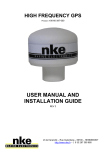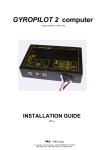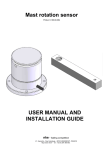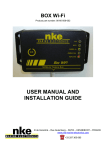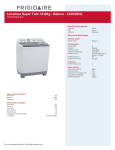Download A.I.S RECEIVER-COMPUTER USER MANUAL
Transcript
A.I.S RECEIVER-COMPUTER Product part number: 90-60-495 USER MANUAL Z.I. Kerandré – Rue Gutenberg – 56700 HENNEBONT- FRANCE http://www.nke.fr – After-sales service 0 33 297 365 685. CONTENT 1 OPERATION ......................................................................................................................... 3 1.1. INTRODUCTION ............................................................................................................ 3 1.2. A.I.S. RECEIVER/PROCESSOR DESCRIPTION......................................................................... 4 1.3. OPERATION ................................................................................................................... 5 1.3.1. Collision avoidance data processing ........................................................................ 5 1.3.2. How is collision avoidance data displayed on the Gyrographic ? ............................. 6 1.3.3. Fault states ............................................................................................................... 7 1.3.3.1. No GPS signal (no-fix or out of order) ................................................................ 7 1.3.3.2. Lost connection between the Gyrographic and the A.I.S Receiver/Processor ... 7 1.4. TECHNICAL SPECIFICATION ....................................................................................... 8 2 FIRST-LEVEL TROUBLESHOOTING .................................................................................. 8 3 INSTALLATION .................................................................................................................... 8 3.1. 3.2. 3.3. 3.4. 4 LIST OF ACCESSORIES ...................................................................................................... 8 INSTALLATION CAUTION ................................................................................................... 8 MOUNTING THE A.I.S. RECEIVER/PROCESSOR UNIT ............................................... 8 CONNECTING THE A.I.S. RECEIVER/PROCESSOR UNIT .......................................... 9 GLOSSARY ........................................................................................................................ 11 -2- 33-60-049-000 AIS Receiver–processor / User manual 1 OPERATION 1.1. INTRODUCTION Thank you for purchasing the nke A.I.S. receiver-processor. A.I.S. (Automatic Identification System) is a worldwide system for exchanging information between ships and stations ashore. A.I.S uses dedicated VHF frequencies to automatically broadcast information such as ship’s identification, status, position and route. This information is available to any ship or traffic control station within the signal reception area. This data, combined with information coming from the GPS, allows the nke AIS ReceiverProcessor to calculate collision risks and to send an alarm to the nke Gyrographic (version 3.20 and up) out in the cockpit. DISCLAIMER Data provided by the nke A.I.S. receiver-processor provides an indication only. The users acknowledge that they are aware that data received can be partial and / or incorrect and that they are solely responsible for any risks related to the use of this instrument. In no event shall nke be liable for any direct, indirect, incidental, or consequential damage related to the use of this instrument. IMPORTANT Please take time to read this manual carefully before you start installation Any connection to the TOPLINE bus must be performed through the specific interface box # 90-60-417 and only with the TOPLINE bus cable # 20-61-001 System configuration AIS - Collision Danger Ship MMSI 923456789 Bearing: 69° Dist: 9.0Mn Colision data: Time: 35min Dist: 2.0Mn Ship MMSI 785234468 Bearing:23° Dist: 6.4Mn Collision data: Time: 19min Dist: 1.2Mn GPS Ent 1 1 Sto p Aut o Green NMEA+ NMEA- init NMEA+ NMEA- NOIR GND BLANC NOIR GND BLANC GND NOIR GND BLANC 12V Yellow Pag e connetion box 90-60-417 Figure 3 : Connection AIS Receiver to the Gyrographic -3- 33-60-049-000 AIS Receiver–processor / User manual 1.2. A.I.S. RECEIVER/PROCESSOR DESCRIPTION The nke A.I.S. Receiver/Processor combines a highly sensitive receiver working on the 2 VHF frequencies dedicated to A.I.S. with an internal programmable processor to calculate the range and bearing of the alarm target, its CPA (Closest Point of Approach) and TCPA (Time Closest Point of Approach). A rotating button allows the selection between 4 alarm ranges: 1. Off 2. Alarm if CPA < 6 nautical miles and TCPA < 30 minutes 3. Alarm if CPA < 4 nautical miles and TCPA < 20 minutes 4. Alarm if CPA < 2 nautical miles and TCPA < 15 minutes The LED indicator will flash green when the unit receives a valid signal from the GPS, and red when receiving A.I.S. messages. The GPS input uses a 2 wire connection. NMEA output sentence « RMC » must be selected on the GPS unit. A VHF antenna for A.I.S. reception is connected to the BNC socket. A 2 wire connection (NMEA+ and NMEA-) outputs the signal to the RS232 port of a PC. All A.I.S data received by the Receiver/Processor can be used by a dedicated software. A 5 wire cable connects the Receiver/Processor to the Topline system. The Gyrographic display will receive the alarm messages. The Topline bus also supplies power to the A.I.S Receiver/Processor . Rotating button LED GPS signal input To the Gyrographic VHF antenna Output to PC -4- 33-60-049-000 AIS Receiver–processor / User manual 1.3. OPERATION 1.3.1. Collision avoidance data processing The A.I.S Receiver/Processor continually processes the signals received on the 2 A.I.S. frequencies. For each A.I.S. message received, it will check the safety zone and generate alarms according to the level activated: Alarm if CPA < 6 nautical miles and TCPA < 30 minutes Alarm if CPA < 4 nautical miles and TCPA < 20 minutes Alarm if CPA < 2 nautical miles and TCPA < 15 minutes CPA, TCPA, bearing and distance of the target are calculated and sent to the Gyrographic. Alarm principle The CPA and TCPA values are chosen with the rotating button to define the safety range. The unit will generate an alarm if a target is detected and its CPA and TCPA are both below the level defined. Target TCPA 20 mn 4 nauticals milles in ar Be g ce tan s i /d TCPA 10 mn A CP TCPA e iv at l Re se ur co Figure 2: Alarm range CPA<4 Mn and TCPA<15 minutes In the example (figure 2) the alarm level selected is « CPA < 4 Nm and TCPA < 20 minutes ». When the value of the CPA calculated is below 4 nautical miles and the TCPA calculated is less than 20 minutes, an alarm message will be sent to the Gyrographic. For CPA below 4 nautical miles with a TCPA greater than 20 minutes, no alarm will be sent. -5- 33-60-049-000 AIS Receiver–processor / User manual 1.3.2. How is collision avoidance data displayed on the Gyrographic ? When receiving the first collision avoidance message from the A.I.S Receiver/Processor the system sounds an alarm and displays a Collision Alert page on the Gyrographic. Page AIS COLLISION DANGER ! Press the Page Ent 1 1 Stop Auto button once to quit the alarm and display the collision avoidance data. WARNING Page Pressing the button quits the COLLISION ALERT page as long as the unit receives collision avoidance messages. It will be active again in standby mode 30 seconds after the reception of the last collision avoidance message. Collision avoidance data: Target’s MMSI number AIS - Collision Danger SHIP MMSI 923456789 BEARING:69° Dist: 9.0Mn Collision data: Time: 35min Dist: 2.0Mn Bearing and distance to the target Page Ent 1 1 TCPA Stop Auto CPA -6- 33-60-049-000 AIS Receiver–processor / User manual The collision avoidance page can display data for two targets simultaneously. The target with the lowest CPA value will display on the top. Page AIS - Collision Danger Ship MMSI 923456789 Bearing: 69° Dist: 9.0Mn Colision data: Time: 35min Dist: 2.0Mn Ent 1 Ship MMSI 785234468 Bearing:23° Dist: 6.4Mn Collision data: Time: 19min Dist: 1.2Mn 1 Stop Auto You can scroll through the pages “Pilot”, “Multifunction”, “Main Menu” and back to « A.I.S » at any time by pressing the Page button. 1.3.3. Fault states 1.3.3.1. No GPS signal (no-fix or out of order) If the system receives invalid GPS sentences (GPS no-fix) the collision avoidance data will be processed with the last valid GPS position data received within the last 4 minutes. If GPS position data has been invalid for longer than 4 minutes, the A.I.S. page will be frozen and will no longer be available once the user displays another page (i.e. “Pilot”…). 1.3.3.2. Lost connection between the Gyrographic and the A.I.S Receiver/Processor If the Gyrographic and the A.I.S Receiver/Processor are not able to communicate, the Gyrographic will display an alarm message. Page AIS CONNECTION LOST ! -7- Ent 1 1 Stop Auto 33-60-049-000 AIS Receiver–processor / User manual 1.4. TECHNICAL SPECIFICATION • Dual frequencies (161.975 MHz – 162.025 MHz simultaneously) • Sensitivity <-106dbm • Processes both AIS class (A and B) messages • Power supply: 12 volts • Power consumption: ~ 100mA • GPS input NMEA0183 (4800 bauds). Uses « RMC » NMEA sentence • PC output NMEA0183 (38400 bauds). « RMC » sentences are multiplexed with A.I.S. messages. • Protection IP20 (not waterproof) • Weight 250g • Dimensions: 145mm x 65 mm x 40 mm 2 FIRST-LEVEL TROUBLESHOOTING In this section you will find information to help you handle small problems yourself. Please take time to read the table for solutions before calling technical support. Issue Possible Causes and solutions GPS is powered on but the LED indicator does not Check the GPS output. NMEA 4800 bauds and « RMC » flash green sentence outputs are required. The LED indicator does not flash red, while a vessel Check wiring for VHF antenna or splitter transmitting A.I.S. is in range Check the serial port parameters. The RS232 input must The PC navigation software does not read any be 38400 bauds A.I.S nor GPS data In the event that you cannot solve the problem by yourself, please contact you dealer. 3 INSTALLATION 3.1. LIST OF ACCESSORIES - 90-60-417: Topline connection kit. Junction box and cables. 3.2. INSTALLATION CAUTION The A.I.S Receiver/Processor is not waterproof. It must be installed in a protected environment. 3.3. MOUNTING THE A.I.S. RECEIVER/PROCESSOR UNIT The unit is fastened with Ø 4mm screws. -8- 33-60-049-000 AIS Receiver–processor / User manual Dimensions in mm Figure 3 3.4. CONNECTING THE A.I.S. RECEIVER/PROCESSOR UNIT WARNING All Topline bus connections must be performed while the system is powered off. The Gyrographic chosen to display A.I.S data must be exclusively dedicated and not receive any other NMEA data. Run the cable from the junction box situated near the dedicated Gyrographic to the A.I.S. display. - Connect the white wires and the shield in the junction box - Connect the green wire to NMEA – position, and the yellow wire to NMEA+ position - Use the BNC socket to connect either the VHF antenna that you dedicate to A.I.S., or the splitter box if you use the existing VHF antenna. - Connect the GPS to the GPS input. Check that the GPS unit outputs « RMC ». - Connect the 9 pin plug to the serial port of the PC running navigation software with A.I.S. features. Use either a serial RS232 port or a USB/RS232 adaptor. -9- 33-60-049-000 AIS Receiver–processor / User manual AIS - Collision Danger Ship MMSI 923456789 Bearing: 69° Dist: 9.0Mn Colision data: Time: 35min Dist: 2.0Mn Ship MMSI 785234468 Bearing:23° Dist: 6.4Mn Collision data: Time: 19min Dist: 1.2Mn GPS Ent 1 1 Sto p Aut o Green NMEA+ NMEA- init NMEA+ NMEA- NOIR GND BLANC NOIR GND BLANC NOIR GND BLANC GND 12V Yellow Pag e connetion box 90-60-417 Figure 4 : Connection AIS Receiver to the Gyrographic Should you need to reduce cables lengths, we recommend tinning the ends before connecting. • Gyrographic cable wires color codes Gyrographic cable wires Function White + 12 volts Shield GND Black NC Red NC Yellow + NMEA Green - NMEA • GPS connection cable wires color codes GPS cable Function Brown + NMEA White - NMEA - 10 - 33-60-049-000 AIS Receiver–processor / User manual • PC connection cable wires color codes PC cable Function Brown + NMEA (pin 2 bD) White - NMEA (pin 5 bD) 4 GLOSSARY AIS (Automatic Identification System) is a worldwide navigation information exchange system. It is automated and permits vessels and shore stations to exchange information such as identity, status, position and route using the VHF radio signal. MMSI (Maritime Mobile Service Identity), is a unique 9 digit code which identifies each vessel. CPA (Closest Point of Approach) is the shortest distance to the meeting point of two vessels in approach. TCPA (Time Closest Point of Approach) is the time remaining until CPA . - 11 - 33-60-049-000 AIS Receiver–processor / User manual











